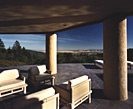 |
Does Sonoma County have a defining architectural style? Begins with a "Z." In his school days, architect Robert Zinkhan's name often made him the last one called on. These days he's often called on first when clients are looking to design a custom home in the hills of Sonoma County. Zinkhan is a practicing local architect, with some 25 years under his pencil. His name is not a household word, unless of course you happen to live in one of his 50+ homes or 50+ remodels. Then it's a name spoken with respect, admiration and downright adoration for the stunning homes lovingly lived in. Strictly a residential designer in Sonoma and Napa valleys, he has some definite opinions about architecture and some definitive showplaces to illustrate them. I was intrigued by his article on the American Institute of Architects (AIA), Redwood Empire Chapter web site (www.aiare.org), entitled, "The Modern Country Home." I met with him over coffee at Railroad Square's Flying Goat to discuss his views on the challenge faced by today's architects (often under pressure by clients) to avoid the temptation to succumb to totally derivative design. Examples would be placing a "Country French," "Tudor Manor," or "Tuscan Villa" in our golden hills or green valleys, which are neither the French, English nor Italian countryside. After all, Sonoma County is its own place, and, Zinkhan believes as such might have its own architectural representation. While it's probably "too late" and likely even undesirable to create a definitive style for Sonoma County, something immediately recognizable like "Santa Fe" style or "Santa Barbara" style, we have here no less a distinctive sense of place. Zinkhan recollects what may have been closest to a recognizable and repeated "Sonoma Style" evolved during the '70's and '80's, influenced heavily by world-renowned Sea Ranch architecture. The defining materials, inside and out, were wood, specifically redwood. Unfortunately, redwood is difficult to maintain in the long-term and some of the exteriors of these buildings have not aged well. This was a materials-driven style. "Sea Ranch remains an excellent example of a regional form of architecture that literally grew out of the surroundings of the buildings. The team translated context, materials and siting into a place where modern architecture really blossomed. It became an architectural dogma that may at this later point in time actually be preventing 'movement' of design there due to strict design review. The high bar that was originally set for design may now have become a pattern approach," explains Zinkhan. A somewhat newer Sonoma style might be the use of agricultural building elements and materials (such as corrugated metal, silos, etc.) as translated into homes. So, I asked (innocently, of course), "How would you define Sonoma style, Bob?" No shrinking violet this architect, he plunged in bravely. "A country home in this particular part of the world invites a strong connection with indoors to outdoors. And, just because a home is 'in the country' does not mean it needs to look like anything in particular, anything that is whatever someone's preconceived definition is of a 'country home.' Even more than that, it doesn't need to be derivative in the least, as in the case of 'Build us a Country French home.' Good architecture is at best very honest. It's honest about the site, the climate, the culture, the times, the materials. And with all these, the utterly personal nature of a home as it relates to those who will live there." Zinkhan's homes are what some might label as "contemporary." My experience of his designs is that the homes are certainly minimal in their lines and shape and inset into the landscape. But they are not "contemporary" in what I have seen to be the sometimes cold, gleaming metallic homes of the contemporary genre. His choice of words might be "modern." He explains that "modern" has come to mean, in many minds, a particular style that includes other terms such as modernist and modernism. These define an architectural vocabulary that probably began in the 1950's as a pared-down, streamlined design style. Zinkhan's homes are streamlined but the lines seem more organic, more related to the particular sites of each. He uses materials that reference the term "country living" because of their warmth and their strength, and their color and texture. Each home feels like a living piece of artwork within which the art of living takes place. Says Zinkhan, "One can create the emotional feel of a country home that everyone seeks with certain materials as opposed to a strict design style. Stone floors, wood, materials in any form, can communicate the emotion that living closer to nature evokes. I try to liberate the materials from preconceived forms so that the architecture is not so formulaic." Read More... |
||||